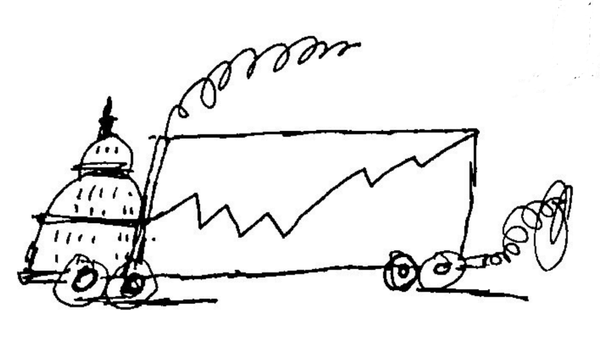Starting with his first presidential campaign, Donald Trump has made high tariff barriers the centerpiece of his plan to restore US industry. Tariffs give a price advantage to domestic producers over foreign exporters, which creates an incentive to expand capacity and replace imports. But it will take more than tariffs to revive American manufacturing. There are other obstacles, including a tax system rigged against capital-intensive investment. But most important, a decades-long feeding frenzy on imports has hollowed out the labor force, depleted engineering talent, and left in a much reduced state the infrastructure and communities that once made American industry the envy of the world. A realistic plan to revive the US industrial base must take all of these factors into account.
For the past 20 years, imports of goods have risen tick-for-tick with US retail sales. Shown below are “real imports of goods” (deflated by the import price index) versus “real retail sales” (deflated by the Consumer Price Index). Each increment in consumer demand was met by an increment in imports.
Americans are also dependent on imports for capital goods. Imports of capital goods exceed our production of capital goods for domestic use. To expand production, we need more capital goods, which requires more imports.
The domestic production of goods has remained stagnant. According to the Federal Reserve, the United States is manufacturing about 5 percent less than it did in 2007, on the eve of the financial crisis. Despite the efforts of both the Trump and Biden administrations to stimulate American manufacturing, output hasn’t increased over the past 10 years.
Meanwhile, manufacturing productivity (output per hour) has been falling since the Great Recession of 2008-2009; American industry is becoming less competitive, not more, as the dotted line in the chart below indicates. The solid line shows capital intensity (the application of machinery and intellectual property to manufacturing), which has stagnated since 2008. This explains the drop in productivity.
In some key industries, the fall in productivity has been catastrophic. Take aircraft manufacturing, once an American monopoly, where labor productivity fell to an index level of only 60 last year, down from 100 in 2018.
The United States has made one major recent attempt to hothouse an industry, namely the Biden administration’s CHIPS and Science Act’s subsidies for domestic production of semiconductors. This prompted a boom in plant construction. But the requisite skilled labor wasn’t available, and the cost of new plant construction jumped by nearly 30 percent between 2022 and 2023. Many CHIPS projects were canceled or delayed for years. The necessary inputs simply weren’t there.
As this makes clear, money by itself isn’t enough. Tariffs give domestic manufacturers a price advantage over foreign competitors, but if the tax system penalizes capital-intensive investment, the educational system doesn’t train workers, and regulators persecute manufacturers, they won’t produce at any price.
“The United States has spent the past quarter-century outsourcing manufacturing.”
The United States has spent the past quarter-century outsourcing manufacturing, neglecting infrastructure, teaching ideology instead of basic skills, and dispersing the communities that once supported manufacturing.
What are the obstacles to expanding US manufacturing? Is it a tax system rigged against capital intensive investment? Is it unstable monetary policy that makes it hard to value assets with a long lifespan? Excessively high interest rates that increase the dollar’s exchange rate and make US goods less competitive? Capricious environmental regulation? Excessive energy costs ? A shortage of skilled labor and engineers? Shrinking federal R&D in high technology? Competition from cheap labor overseas?
If you chose “all of the above,” you get partial credit. China in 2023 had 392 industrial robots for every 10,000 manufacturing workers, as compared to only 285 in the United States. China’s manufacturing sector is more capital-intensive than America’s; last year, the People’s Republic installed more industrial robots than the rest of the world combined.
You need basic high-school math skills (trigonometry and coordinate geometry) to operate a numerically controlled machine, but only 23 percent of US high school students have “basic proficiency” in math, according to the Department of Education. Factories can’t find qualified workers. Engineering schools, for that matter, can’t find qualified applicants. The deterioration starts in grade schools, which are already dealing with a math-teacher shortage. The future isn’t exactly looking bright: The United States awarded just 27,000 bachelor’s degrees in mathematics in 2021.
By my back-of-the-envelope reckoning, America needs to train another 2 million industrial workers and invest about $1 trillion in capital equipment to reverse the quarter-century of rot in manufacturing. There is no magic bullet, just a war of attrition on all fronts.
What do we have to do?
- The corporate tax system (including the 2017 reform) penalizes capital-intensive investment. Allow corporations to write off the whole investment in equipment in the year it’s invested.
- Offer low-interest student loans for degrees in hard science, math, and engineering, and forgive the loan if the student teaches in grade school for six years.
- Use the community-college system to train high-school graduates in industrial skills, in partnership with private industry.
- Restore federal R&D funding to Reagan levels (about 1.3 percent of GDP, double what it is now).
- Slash environmental regulation to fast-track plant construction.
- Protect key industries (like electric vehicles) with tariffs, but don’t impose tariffs across the board; that will raise the cost of capital inputs for US businesses and hurt consumers.
- Build a national 5G (and now 6G) broadband network, a critical factor in industrial automation.
Trump’s GOP now controls both houses of Congress, which gives the president the power to implement a manufacturing recovery program. He should use that power. It might be our last chance to reverse the quarter-century slide in manufacturing.
